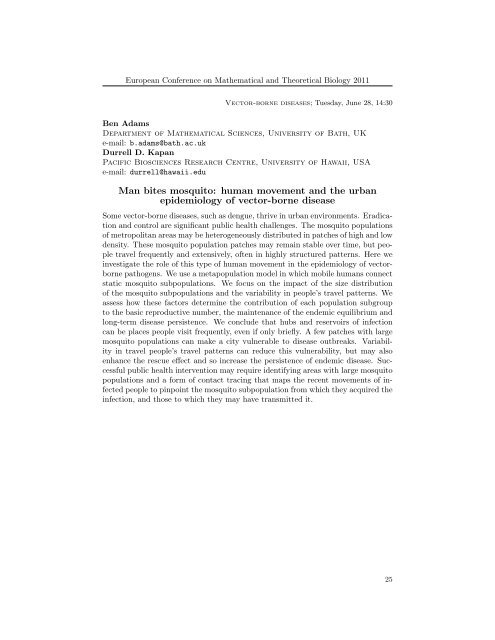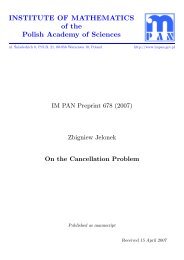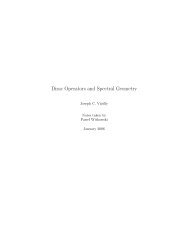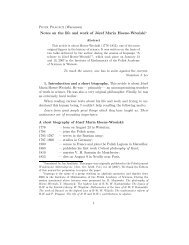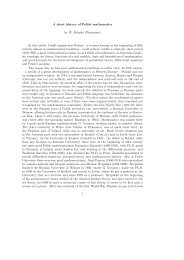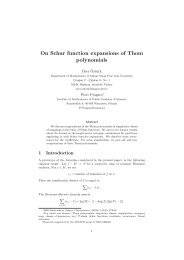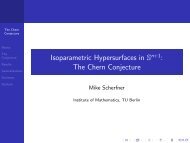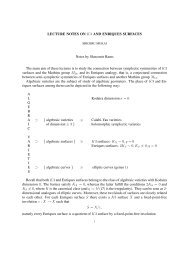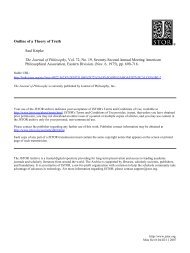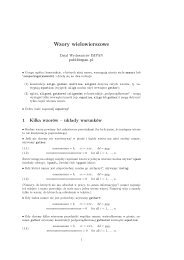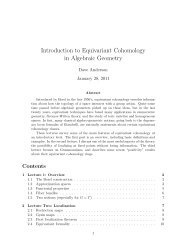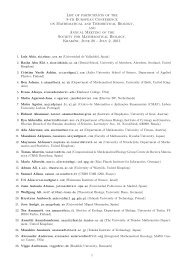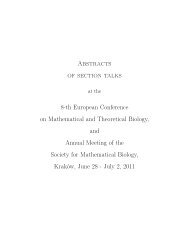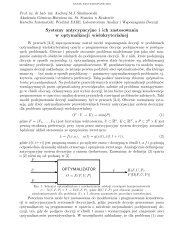Abstracts of Posters 8-th European Conference on Mathematical ...
Abstracts of Posters 8-th European Conference on Mathematical ...
Abstracts of Posters 8-th European Conference on Mathematical ...
Create successful ePaper yourself
Turn your PDF publications into a flip-book with our unique Google optimized e-Paper software.
<str<strong>on</strong>g>European</str<strong>on</strong>g> <str<strong>on</strong>g>C<strong>on</strong>ference</str<strong>on</strong>g> <strong>on</strong> Ma<str<strong>on</strong>g>th</str<strong>on</strong>g>ematical and Theoretical Biology 2011<br />
Vector-borne diseases; Tuesday, June 28, 14:30<br />
Ben Adams<br />
Department <str<strong>on</strong>g>of</str<strong>on</strong>g> Ma<str<strong>on</strong>g>th</str<strong>on</strong>g>ematical Sciences, University <str<strong>on</strong>g>of</str<strong>on</strong>g> Ba<str<strong>on</strong>g>th</str<strong>on</strong>g>, UK<br />
e-mail: b.adams@ba<str<strong>on</strong>g>th</str<strong>on</strong>g>.ac.uk<br />
Durrell D. Kapan<br />
Pacific Biosciences Research Centre, University <str<strong>on</strong>g>of</str<strong>on</strong>g> Hawaii, USA<br />
e-mail: durrell@hawaii.edu<br />
Man bites mosquito: human movement and <str<strong>on</strong>g>th</str<strong>on</strong>g>e urban<br />
epidemiology <str<strong>on</strong>g>of</str<strong>on</strong>g> vector-borne disease<br />
Some vector-borne diseases, such as dengue, <str<strong>on</strong>g>th</str<strong>on</strong>g>rive in urban envir<strong>on</strong>ments. Eradicati<strong>on</strong><br />
and c<strong>on</strong>trol are significant public heal<str<strong>on</strong>g>th</str<strong>on</strong>g> challenges. The mosquito populati<strong>on</strong>s<br />
<str<strong>on</strong>g>of</str<strong>on</strong>g> metropolitan areas may be heterogeneously distributed in patches <str<strong>on</strong>g>of</str<strong>on</strong>g> high and low<br />
density. These mosquito populati<strong>on</strong> patches may remain stable over time, but people<br />
travel frequently and extensively, <str<strong>on</strong>g>of</str<strong>on</strong>g>ten in highly structured patterns. Here we<br />
investigate <str<strong>on</strong>g>th</str<strong>on</strong>g>e role <str<strong>on</strong>g>of</str<strong>on</strong>g> <str<strong>on</strong>g>th</str<strong>on</strong>g>is type <str<strong>on</strong>g>of</str<strong>on</strong>g> human movement in <str<strong>on</strong>g>th</str<strong>on</strong>g>e epidemiology <str<strong>on</strong>g>of</str<strong>on</strong>g> vectorborne<br />
pa<str<strong>on</strong>g>th</str<strong>on</strong>g>ogens. We use a metapopulati<strong>on</strong> model in which mobile humans c<strong>on</strong>nect<br />
static mosquito subpopulati<strong>on</strong>s. We focus <strong>on</strong> <str<strong>on</strong>g>th</str<strong>on</strong>g>e impact <str<strong>on</strong>g>of</str<strong>on</strong>g> <str<strong>on</strong>g>th</str<strong>on</strong>g>e size distributi<strong>on</strong><br />
<str<strong>on</strong>g>of</str<strong>on</strong>g> <str<strong>on</strong>g>th</str<strong>on</strong>g>e mosquito subpopulati<strong>on</strong>s and <str<strong>on</strong>g>th</str<strong>on</strong>g>e variability in people’s travel patterns. We<br />
assess how <str<strong>on</strong>g>th</str<strong>on</strong>g>ese factors determine <str<strong>on</strong>g>th</str<strong>on</strong>g>e c<strong>on</strong>tributi<strong>on</strong> <str<strong>on</strong>g>of</str<strong>on</strong>g> each populati<strong>on</strong> subgroup<br />
to <str<strong>on</strong>g>th</str<strong>on</strong>g>e basic reproductive number, <str<strong>on</strong>g>th</str<strong>on</strong>g>e maintenance <str<strong>on</strong>g>of</str<strong>on</strong>g> <str<strong>on</strong>g>th</str<strong>on</strong>g>e endemic equilibrium and<br />
l<strong>on</strong>g-term disease persistence. We c<strong>on</strong>clude <str<strong>on</strong>g>th</str<strong>on</strong>g>at hubs and reservoirs <str<strong>on</strong>g>of</str<strong>on</strong>g> infecti<strong>on</strong><br />
can be places people visit frequently, even if <strong>on</strong>ly briefly. A few patches wi<str<strong>on</strong>g>th</str<strong>on</strong>g> large<br />
mosquito populati<strong>on</strong>s can make a city vulnerable to disease outbreaks. Variability<br />
in travel people’s travel patterns can reduce <str<strong>on</strong>g>th</str<strong>on</strong>g>is vulnerability, but may also<br />
enhance <str<strong>on</strong>g>th</str<strong>on</strong>g>e rescue effect and so increase <str<strong>on</strong>g>th</str<strong>on</strong>g>e persistence <str<strong>on</strong>g>of</str<strong>on</strong>g> endemic disease. Successful<br />
public heal<str<strong>on</strong>g>th</str<strong>on</strong>g> interventi<strong>on</strong> may require identifying areas wi<str<strong>on</strong>g>th</str<strong>on</strong>g> large mosquito<br />
populati<strong>on</strong>s and a form <str<strong>on</strong>g>of</str<strong>on</strong>g> c<strong>on</strong>tact tracing <str<strong>on</strong>g>th</str<strong>on</strong>g>at maps <str<strong>on</strong>g>th</str<strong>on</strong>g>e recent movements <str<strong>on</strong>g>of</str<strong>on</strong>g> infected<br />
people to pinpoint <str<strong>on</strong>g>th</str<strong>on</strong>g>e mosquito subpopulati<strong>on</strong> from which <str<strong>on</strong>g>th</str<strong>on</strong>g>ey acquired <str<strong>on</strong>g>th</str<strong>on</strong>g>e<br />
infecti<strong>on</strong>, and <str<strong>on</strong>g>th</str<strong>on</strong>g>ose to which <str<strong>on</strong>g>th</str<strong>on</strong>g>ey may have transmitted it.<br />
25


